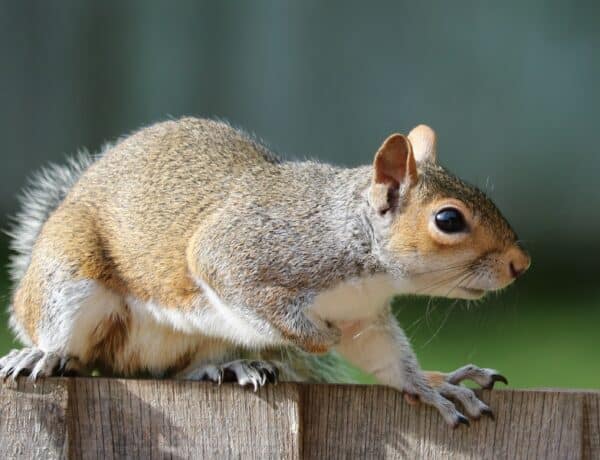Introduction
Why Do Squirrels Make Noise: Squirrel vocalizations, although often overlooked or dismissed as mere chatter, serve a crucial role in their lives. Like many animals, squirrels communicate primarily for three main reasons to express emotions, warn of danger, and establish territory. Understanding these vocalizations can offer valuable insights into the behavior and social dynamics of these arboreal creatures. First and foremost, squirrels use their voices to convey their emotions. Just like humans, they experience a range of feelings, from excitement and contentment to fear and agitation.
Squirrels emit high-pitched chirps or rapid chatters when they are excited, happy, or playful. These cheerful sounds are often heard during acrobatic tree-climbing displays or playful chases with fellow squirrels. On the other hand, when squirrels feel threatened or alarmed, they resort to a different set of vocalizations. Their alarm calls, consisting of loud and repetitive chattering or squirrels barking, serve as a warning to others in their community. These urgent calls are meant to alert fellow squirrels to the presence of potential predators, such as hawks, cats, or snakes.
The sharpness and intensity of these vocalizations can vary depending on the perceived level of danger, crucial information to the group. Squirrels also use their voices to establish and defend their territories. Territorial disputes among squirrels are common, and vocalizations play a pivotal role in asserting dominance and delineating boundaries. When a squirrel enters another’s territory, a series of aggressive vocalizations may ensue, including scolding calls and growls. Squirrel chatter and uncover the hidden meanings behind their vocal symphony.

What does it mean when a squirrel keeps making noise?
Squirrel Vocalizations
According to mammologist Bryan Harding, squirrels use sound to protect themselves and their territories. Their alarm calls are made up of screeches, rattles, barks, and snorts. The kuk, muk-muk, and quaa sounds are used to convey an interest in mating.
Expressing Emotions: Squirrels, like humans, experience a range of emotions. When a squirrel is making noise, it may be expressing its feelings. For instance, high-pitched chirping or rapid chattering often indicates excitement, happiness, or playfulness. These sounds are commonly heard during acrobatic displays in trees or during playful interactions with other squirrels.
Warning of Danger: One of the most common reasons squirrels make noise is to warn others of potential danger. When they detect the presence of predators, such as hawks, cats, or snakes, squirrels emit loud and repetitive alarm calls. These calls can vary in intensity and urgency depending on the perceived level of threat. Other squirrels in the vicinity heed these warnings and take cover to avoid becoming prey.
Territorial Communication: Squirrels are territorial animals, and they use vocalizations to establish and defend their territories. When two squirrels meet at the boundary of their respective territories, they may engage in a vocal confrontation. This can involve scolding calls, growls, or other aggressive noises, serving to assert dominance and delineate territorial boundaries.
Why do squirrels make a quack sound?
Squirrels have two mating seasons, in January and February and again in June and July. “The female goes to the top of a branch and makes a sound that sounds like a duck,” he says. “They’re trying to find a mate. The males will fight to get to her, showing their strength and dominance.
“Whether or not they use kuks doesn’t really tell you much about what’s going on other than something is upsetting the squirrel,” says McRae. Squirrels made quaas more often in response to terrestrial threats, but sometimes used them when an aerial threat approached, as well.
Distress Calls: When squirrels are in distress or feeling threatened, they may emit a series of loud, high-pitched chirps or squeals that might be mistaken for quacking. These distress calls are meant to alert other squirrels in the area to potential danger and can serve as a warning to stay away.
Mating Calls: During the mating season, male squirrels often produce a variety of vocalizations, including clicking and chattering sounds, which may occasionally sound like quacks. These calls are part of their courtship rituals to attract female squirrels.
Social Communication: Squirrels are social animals and use a range of vocalizations to communicate with each other within their groups. These sounds can include soft chirping and chattering. While they may not precisely resemble quacks, they are part of the broader spectrum of squirrel communication.
Do squirrels make warning sounds?
Squirrels closely mimic bird warning calls and help spread the alarm through the forest that hawks, owls or other predators are nearby.
Squirrels often use whistles as alarm calls, alerting others to potential threats. The high pitch and distinctive tone of the whistle make it easily distinguishable from other sounds, ensuring it grabs the attention of other species.
Squirrels emit alarm calls when they perceive a potential threat. These calls are typically loud, high-pitched, and repetitive. While the specific vocalizations can vary among different squirrel species, they often sound like rapid chattering or sharp squeaks. These alarm calls serve as an urgent warning to other squirrels in the area that danger is nearby.
Squirrels are prey animals, and they have evolved to be extremely alert to the presence of predators. When a squirrel spots a potential threat, such as a circling hawk or a lurking cat, it will emit alarm calls to notify other squirrels to be on guard. This communal alert system increases the chances of detecting and avoiding danger.
The intensity and urgency of squirrel alarm calls can vary depending on the perceived level of threat. For example, if a distant hawk is spotted, the alarm calls may be less intense than when a predator is nearby. This variability in vocalizations helps convey the level of danger accurately. When squirrels hear alarm calls from a fellow squirrel, they typically respond by freezing in place or quickly seeking cover.
Do squirrels have rabies?
Small rodents (like squirrels, hamsters, guinea pigs, gerbils, chipmunks, rats, and mice) and lagomorphs (including rabbits and hares) are almost never found to be infected with rabies and have not been known to transmit rabies to humans.
Behavior: Squirrels are generally not aggressive animals and tend to avoid confrontation with larger mammals, including humans. They are more likely to flee than to attack if they feel threatened. This behavior makes it less likely for them to come into close contact with potential rabies carriers.
Diet: Squirrels are herbivores, primarily feeding on nuts, seeds, fruits, and vegetation. They do not typically prey on animals, so their chances of encountering rabies-infected animals, such as raccoons, bats, or skunks, are lower than those of carnivorous or omnivorous animals.
Low Susceptibility: While it is theoretically possible for any mammal to contract rabies, some species are more susceptible than others. Squirrels are not considered highly susceptible to rabies. The virus would need to pass through several stages of infection in their body before it could be transmitted.
How do you stop squirrels from making noise?
You can use loud noises to keep squirrels away from your home. Sounds from humans, such as loud laughter, yelling, and noisy conversations will scare them. High-volume music and the sound of predatory birds can also startle squirrels, causing them to stay away.
Sounds from humans, such as loud laughter, yelling, and noisy conversations will scare them. High-volume music and the sound of predatory birds can also startle squirrels, causing them to stay away.
Identify the Source of Noise: First, try to determine the source of the noise. Squirrel noises can come from their activities like climbing, jumping, and foraging, or it can be vocalizations like chirping and chattering. Identifying the specific behavior can help you decide on the most effective approach.
Block Entry Points: If squirrels are getting inside your home or attic and making noise, the best solution is to block their entry points. Use materials like wire mesh or caulking to seal gaps, holes, and vents where they may be entering. Make sure you do this safely, as squirrels may be inside when you seal their access points.
Trim Trees and Branches: If squirrels are using nearby trees or branches as launch points to access your property, consider trimming back these branches to make it more difficult for them to reach your house. This can discourage their presence near your home.
How do squirrels show anger?
When confronted with a frustrating task, fox squirrels—close biological cousins of common gray squirrels, but the species more likely to hang out on Berkeley turf—arc and swish their tails to signal their displeasure, according to a study published last month in the Journal of Comparative Psychology.
Tail Flicking: One of the most common signs of an agitated squirrel is tail flicking. When a squirrel rapidly twitches or flicks its tail, it’s often a sign of irritation or annoyance. This behavior can be observed during interactions with other squirrels, as well as when they encounter perceived threats or disturbances.
Vocalizations: Squirrels may vocalize their frustration through a series of sharp chattering or scolding calls. These sounds can be quite loud and intense when they are agitated. Vocalizations are often used during territorial disputes or confrontations with other squirrels.
Aggressive Behavior: When squirrels are angry or feel threatened, they may exhibit aggressive behaviors. This can include lunging at or chasing another squirrel or engaging in physical confrontations. While squirrels are generally not aggressive animals, they can become combative when their territory or resources are at stake.
How do squirrels show emotion?
Inspired by Darwin, Delgado was intrigued by squirrels’ emotional worlds. Though fox squirrels chatter their teeth, they don’t really make any facial expressions like we do to signal our sadness, anger or surprise. The way to tell what they’re feeling, researchers have found, is to watch their tails.
Excitement and Happiness: Squirrels often exhibit excitement and happiness through energetic and playful behavior. They may engage in acrobatic displays, including leaping from branch to branch, chasing one another, and performing somersaults in the air. Their tails, which are a significant part of their expressive body language, may stand erect and flicker rapidly when they are excited or happy.
Fear and Anxiety: When squirrels feel threatened or anxious, they display signs of fear. This can include sudden freezing in place, wide-eyed stares, and rapid scanning of their surroundings. They may also emit high-pitched alarm calls or chatter loudly to warn others about potential danger.
Contentment: Squirrels may demonstrate contentment when they are enjoying a meal or resting comfortably. They often have a relaxed posture, with their bodies sprawled out or perched comfortably on a tree branch. During these moments, they may groom themselves or take naps to signify their content state.
How do I know if my squirrel has rabies?
You can’t tell if an animal has rabies by just looking at it—the only way to know for sure if an animal (or a person) has rabies is to perform laboratory testing. However, animals with rabies may act strangely. Some may be aggressive and try to bite you or other animals, or they may drool more than normal.
Erratic Behavior: Rabies can cause animals to exhibit erratic and unusual behavior. If you observe a squirrel acting aggressively, overly lethargic, or disoriented, it may be a cause for concern. However, other factors, such as injury or illness, can also lead to similar behaviors.
Foaming at the Mouth: One classic sign of rabies in animals is foaming at the mouth. This occurs because the virus affects the salivary glands, causing excessive drooling and foam around the mouth. However, not all rabid animals exhibit this symptom.
Difficulty Swallowing: Rabies can lead to difficulty swallowing, resulting in a squirrel appearing to choke or having trouble eating or drinking. This symptom can make it challenging for an infected squirrel to consume food or water. Infected animals may become unusually aggressive and may approach humans or other animals in a hostile manner. They may lunge, bite, or scratch without provocation.

Conclusion
In squirrels, their vocalizations serve as a crucial tool for communication, allowing these seemingly simple creatures to navigate the intricate web of their lives. From expressing emotions to warning of danger and establishing territory, the sounds they produce reveal the depth and complexity of their existence. As we squirrels make noise, we can draw several key insights and reflections from this captivating subject. Firstly, squirrel vocalizations highlight the emotional richness of these animals. Much like humans, they experience joy, excitement, fear, and agitation. Their high-pitched chirps of delight during playful moments or their urgent chattering in response to threats remind us that emotions are not exclusive to our species.
These vocal expressions enable squirrels to bond with each other, forming close-knit communities that share in the highs and lows of life in the wild. Secondly, squirrel vocalizations underscore the of vigilance in their survival strategy. The world of a squirrel is fraught with dangers, from predatory birds soaring overhead to ground-dwelling foes waiting to pounce. The ability to convey alarm through loud and distinctive calls is a lifesaving skill, enabling squirrels to rally their companions in times of peril. These warning signals are a testament to the adaptive nature of these animals and their ability to communicate effectively under pressure.
Squirrel vocalizations reveal the intricate social dynamics within their communities. Territorial disputes, often accompanied by vocal confrontations, illustrate the hierarchy and squirrel variation boundaries that govern their interactions. These exchanges are not just noise; they are a means of resolving conflicts without resorting to physical violence, minimizing potential harm within their tightly knit groups. In squirrels, making noise unravels a world of communication that is far from trivial. Squirrel vocalizations are not mere background chatter but a symphony of expressions, warnings, and declarations. They paint a vivid picture of these small, elusive creatures’ lives, showcasing their resilience and adaptability in the face of challenges.





No Comments